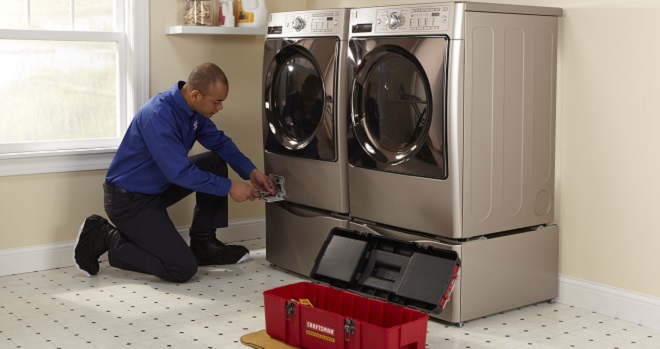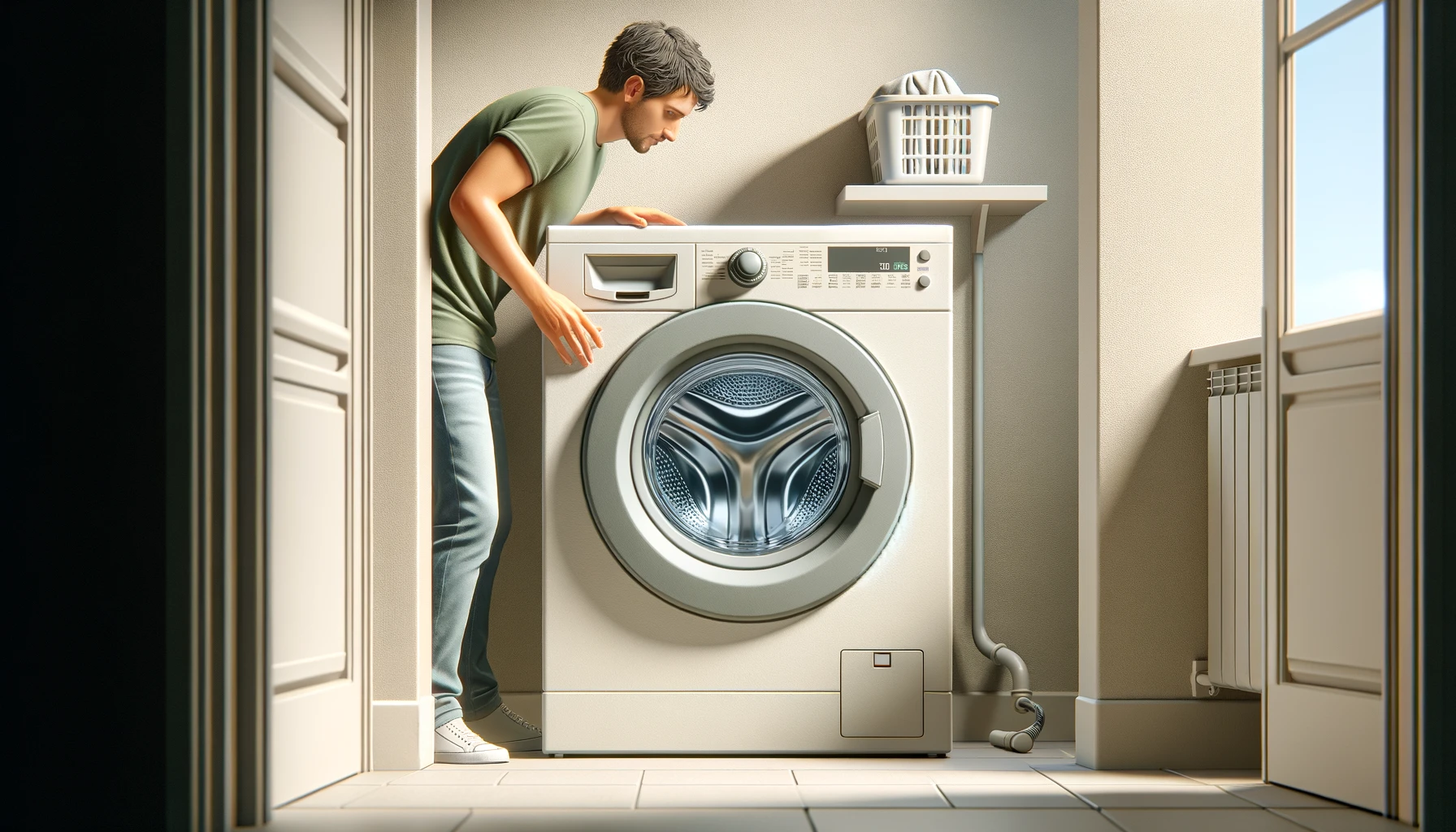Schedule washer maintenance now!
How to Save Money by Using Your Washer Efficiently
Efficiently using your washer is not only environmentally friendly but also helps you save money on energy and water bills. Discover expert tips to optimize your washer's performance and reduce operating costs, from following the owner's manual instructions to selecting the right cycles and settings for each load of laundry.
KEY TAKEAWAYS
- Following the instructions in the owner’s manual helps in using the washing machine efficiently, potentially saving energy and water.
- Correctly installing the washer ensures it operates efficiently; improper installation can lead to issues like improper drainage and increased energy usage.
- Selecting the appropriate cycle settings, sorting laundry properly, and using the right water temperature can save water, energy, and prolong the lifespan of the washer.
By implementing these strategies, you can cut down on energy consumption, extend your washer's lifespan, and keep your utility bills in check.
Read and Follow Owner’s Manual Instructions
This first tip seems like a no-brainer, but many of us never read the owner’s manual for any of our appliances – including the washer. We just play it by ear or figure out how to use it as we go along. You can miss some significant money-saving advice if you forego this important step.
Read and follow the instructions in your owner's manual to use your washing machine efficiently. Here are some common topics covered in many owner's manual that may help you glean more energy efficiency from your washer.
Make Sure that Your Washer is Installed Properly
It’s important that you install the washing machine correctly so that it works efficiently. For example, if you don’t install the drain hose correctly, the washer won’t drain water properly. Clothes will be wetter than normal when you pull them out of the washer and place them in the dryer. Drying wetter clothes will use more energy and raise your utility bills.
A similar problem can occur if you don’t level the washer properly during installation. Follow the instructions in the owner’s manual or installation guide to level and stabilize the washer so it spins properly.
Follow these general steps to make sure that your washer is stable and level.
- Use a level to check front-to-back and side-to-side leveling of the washer cabinet. If the washer isn’t level, adjust the leveling legs as shown in the owner’s manual or installation guide to level the washer properly.
- With the cabinet leveled properly, check washer stability. All four leveling legs should have full contact with the floor. To check, place your hands on the corners of the empty washer and rock it slightly side to side. If the washer rocks, adjust the legs to eliminate rocking.
- Recheck washer leveling and readjust the legs if needed to level the washer while keeping all 4 leveling legs firmly against the floor to prevent rocking. Leveling can be slightly off as long as all 4 legs are firmly on the floor.
When your washer is installed properly, it will work efficiently to wash the clothes and spin out the water properly so the washer and dryer use less energy.
Use the Right Cycles and Settings to Clean Loads Efficiently
Washing machines have different types of controls. Study the owner’s manual to familiarize yourself with the cycles and settings available on your washer. That way, you’ll be able to use the most efficient settings for each type of load.
Here are some common tips to help you use the right cycles and settings for each load of laundry.
-
Sort laundry properly. Different types of fabrics and garments require different wash cycles and settings. By sorting your laundry, you can identify items that need delicate or gentle cycles which use less energy versus those that require more robust or heavy-duty cycles. Sorting laundry properly also allows you to separate clothes based on their recommended water temperature. Here are some laundry sorting tips.
- Sort your laundry into separate piles based on color. Generally, you should separate whites, darks, and colors. This prevents colors from bleeding onto lighter items and keeps your clothes looking their best.
- After sorting by color, you can further separate clothes based on the fabric type. This is particularly important when washing delicate or heavily soiled items. Separate delicate fabrics, such as silk, lace, satin, or items with beading or sequins. These items typically require gentle washing.
- Sort heavy fabrics like towels, bed sheets, and denim separately. You can use heavy-duty cycles to wash these items.
-
Select the right cycle settings. Now that you have laundry sorted, choose the appropriate cycle and temperature setting when loading each batch.
- Choose the best water level for each load. Many HE (high efficiency) washers automatically detect load size and choose the water level for you. As long as you avoid overloading the washer, the automatic water level will be sufficient for cleaning the clothes. To save energy, resist the temptation to use the Extra Fill or Deep Fill settings that use more water. If you have a washer that lets you manually select water level, choose the right water level for the size of the batch you’re loading. You can save water by choosing lower water levels for lighter loads. Over time, you’ll save money on your water bill by selecting the right water level.
- Choose the cycle appropriate for the batch of laundry that you’re washing. Don’t use the normal or heavy-duty cycle for every load. That will waste energy. Use the shorter delicate cycle to wash fragile garments. Choose the permanent press cycle when appropriate. Using the less-aggressive cycles when needed prevents unnecessary wear and tear on the machine and saves energy.
- Select the cold water temperature setting whenever possible. Unless you have heavily soiled clothes that require hot water, cold water will clean clothes effectively. Using the cold water setting consistently will cut energy consumption of your washer in half. Additionally, use a laundry detergent specifically designed for cold water to make sure clothes get clean.
Making smart choices when selecting cycle settings can save water, energy and washing machine wear. You’ll also notice that clothes looks better and lasts longer.

Don’t Overload the Washer
When you pack your washer too full, clothes don’t have room to agitate. That can cause them to not get clean enough and water won’t spin out of the clothes fully. Wet clothes will take longer to dry in the dryer – wasting a significant amount of energy.
Overloading the washer will also strain components such as the drive motor, drive belt, bearings, seals, suspension springs, dampers and shocks. Worn components can cause the washer to use more energy. You’ll wind up spending money repairs or having to replace the washer more frequently when you overload it.
So, how full is too full? If you’re packing the clothes in tight, that’s your first clue that you’re overloading your washer. Machines vary, so check your manual, but a good rule is to loosely load the clothes and leave at least 6 inches between the top of the load of laundry and the top of the drum.
Maintain your washer
With all of the filling, sloshing, draining and spinning it does, your washing machine needs regular cleaning and maintenance to keep it operating efficiently. Your washer will use less energy when you keep it in top shape with regular maintenance.
Clean the inside of the washer monthly
Use a washer cleaner such as Affresh or Washer Magic to clean the inside of your washing machine. The cleaner removes detergent residue that builds up inside the machine. Excessive detergent residue can cause oversudsing which will prevent the washer from draining and spinning water out of the clothes properly. The dryer will need to use more energy to dry wet clothes. Don’t neglect this important maintenance step to keep your washer working efficiently.
Clean the end of the washer drain hose
Pull the drain hose out of the stand pipe or drain sink and check for residue in the hose opening. Clear any lint or debris clogging the hose. Reinstall the hose in the stand pipe or drain sink.
Keeping the drain hose clear will make sure that the washer efficiently drains out water so clothes are dryer when you transfer them to the dryer. The dryer will use less energy to dry the clothes when you keep the drain hose clear.
Also, the drain pump will use less energy and last longer when you clean the drain hose regularly.

Schedule professional washer maintenance yearly
To keep your washing machine in top condition and operating efficiently, schedule professional Cleaning & Maintenance service yearly.
During washer service, the Sears technician will:
- Inspect water fill hoses. The technician will inspect fill hoses for cracks and wear that can indicate potential failure. The tech will recommend fill hose replacement when it’s likely that a fill hose is at the end of its useful life. This maintenance step will ensure that the washer fills to the properly level for efficient operation.
- Check the washer tub and internal hoses for wear and leaks. During washer maintenance, the technician will check internal fill hoses, dispenser hoses and drain hoses for leaks and wear that need addressing. Making sure that detergent properly dispenses will help the washer work efficiently.
- Test the washer drain system. The washer won’t clean and spin clothes if the drain system doesn’t fully remove water during the drain portion of the cycle. The technician will check drain pump operation and examine the complete drain path through your home’s drain system. The tech can clear obstructions and let you know if your house drain needs clearing. This will help the washer to get clothes as dry as possible before they go into the dryer so that you save energy when drying laundry.
- Check water fill level and water temperature. To keep your washer working efficiently, the technician check water fill levels and the water temperature. The washing machine won’t clean the clothes well if water level is too low. Too much water can cause leaks and damage suspension components. If water temperature controls aren’t working properly, the washer can waste energy.
- Check the suspension system and spin cycle operation. Excessive vibration or banging during the spin will often result in clothes being too wet when the cycle ends. The technician will test the spin cycle and make sure that suspension components such as shock absorbers and springs are intact and working properly. The tech also will check washer leveling and stability and adjust leveling legs as needed to minimize vibration during the spin cycle.
- Run a cleaning cycle. The technician will typically run a cleaning cycle using a washer cleaner to remove deposits and detergent residue from the washer.
Bundle washing machine maintenance with clothes dryer maintenance service to save money and keep both laundry appliances working smoothly and saving energy.
By following these tips, you can use your washing machine efficiently, save energy and water, and prolong the lifespan of your clothes washer. You’ll also help the environment while lowering your water and utility bills.
Schedule washer maintenance now!
Increase the lifespan and performance of your washer with our comprehensive maintenance service, ensuring reliable laundry care and continued peace of mind.
Was this information helpful?
Maintain Washer Resources
Keep your top-load washer running smoothly with our 2024 maintenance checklist.
Discover how to quickly fix and prevent LG front-load washer draining issues with expert advice from Sears Home Services.
Learn how to clean metal rust off the washer with our expert tips.
Discover the 6 benefits of regular washing machine maintenance in 2024 and keep your appliance running smoothly.
